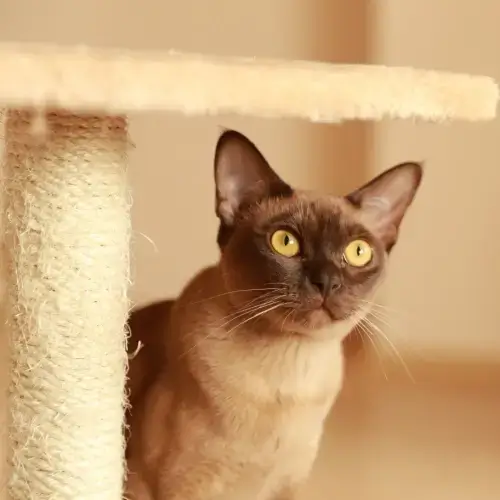Home / Compare Pet Insurance / Information about pet in…




Key takeaways
- Pet insurance can help cover unexpected vet bills for illnesses and injuries, easing financial stress for pet owners.
- Always read the PDS and TMD to ensure that you know the inclusions and exclusions of the policy, and that the policy is the right fit for you.
- The cost of pet insurance depends on your pet and level of cover, so it’s important to compare policies, understand terms and insure pets early for the best value.
What is pet insurance?
Your pet is part of the family, meaning it’s your job to ensure their long-term well-being.
If your fur baby gets sick or is in an accident, you may need to pay thousands of dollars to make them well again. That’s where pet insurance can help alleviate such costs so that you’re never faced with a difficult decision.
Pet insurance helps to cover a portion of your eligible veterinary bills if your cat or dog gets sick or injured. It reimburses some of the costs of treating unexpected injuries and illnesses up to an agreed amount, which is known as your benefit percentage.
Pet insurance should be a serious consideration for pet owners because of the expense of keeping furry companions healthy and caring for seriously ill or injured pets. A good insurance policy may help allay those costs.
How much does pet insurance cost?
Pet insurance is typically relatively affordable, considering some vet bills can cost hundreds or thousands of dollars. You could choose a basic accident and illness policy to cover your pet for specified accidents and ailments or pay more if you want added benefits like routine care.
How are pet insurance premiums calculated?
 Your insurer calculates your pet insurance premium by determining how likely you are to claim on that policy. Your pet insurance premium is recalculated each year at the time of renewal. The following factors could have an impact on premium prices:
Your insurer calculates your pet insurance premium by determining how likely you are to claim on that policy. Your pet insurance premium is recalculated each year at the time of renewal. The following factors could have an impact on premium prices:
Breeds that cost more to insure
Rare breeds, purebreds and ‘designer dogs’ will typically cost more to insure as they’re more prone to certain hereditary conditions, and the same applies to cats and other animals. However, it’s simple enough to find out what conditions they’ll likely require treatment for during their lifetime so that you can be prepared.
Types of pet insurance policies in Australia
While most policies and insurers are different, there are three main types of pet insurance policies in Australia.
Accident-only cover
Accident-only pet insurance is typically the most basic and affordable type of policy. It covers injuries resulting from unexpected accidents, such as car collisions, snake bites or burns. This policy doesn’t cover illnesses, pre-existing conditions, or routine care, so it’s generally best suited for pet owners who want financial protection against sudden, serious incidents but want to keep their premiums low. This may also be the only insurance policy that is offered to senior pets.
Accident and illness cover (Comprehensive cover)
Accident and illness pet insurance offers more comprehensive protection than accident-only cover. In addition to accidents and injuries, it covers a wide range of illnesses, including common conditions like skin infections, gastrointestinal issues, cancer and more. Depending on your level of cover, it may also include more advanced treatments such as surgeries, hospital stays, specialist care and in some cases, alternative therapies. Accident and illness cover usually comes with an option to add routine care coverage, which can extend your level of coverage. However, it typically excludes elective procedures and pre-existing conditions.
Routine care add-on
Routine care is not included in standard pet insurance policies but can often be added as an optional extra. This add-on can help cover the costs of preventative and wellness-related treatments, such as vaccinations, flea and tick treatments, desexing, dental cleaning, microchipping and annual vet check-ups. Benefits are usually capped at a fixed amount per year or item. While not essential, routine care coverage can help reduce out-of-pocket expenses for proactive pet health management.
What should I look for in a pet insurance policy?
Look for a pet insurance policy that is affordable month-on-month (or you could opt to pay an annual lump sum), which can cover significant expenses in the event of an accident or illness. You may also want to consider paying a little extra for subsidised routine care benefits.
Always compare different insurance policies and choose the policy within your financial budget that suits your pet’s needs.
Our comparison service is free to use and can help you spot a great pet insurance policy in just a few clicks! While we don’t compare all brands in the market, we can show you various insurance policies on our panel side by side to give you an idea of cover options available for your pet, inclusions, prices and more.
Read the policy wording on the Product Disclosure Statement (PDS) and the Target Market Determination (TMD) to know what’s included and excluded in your policy, and that the policy is the right fit for you.
Here are some important factors to consider before deciding on a pet insurance policy:
Pick a policy that covers accidents and illnesses
Your primary concern should be finding cover that helps pay for accidents and emergencies, and treatment costs if your pet gets sick. An accident and illness cover can help pay for some of the costs specified in your policy.
Consider the benefit percentage
Most pet insurance products include a benefit percentage − the percentage of the vet bill your insurer will cover, which typically ranges from 70% to 90%. However, some policies may include lower or higher benefit percentages, and some select policies may even cover the total cost (100%) of the vet bill. To get cover for more of your eligible vet bills, look for policies with a 100% benefit percentage and no policy excess.
Check the policy excess
Most pet insurance policies have an excess, which is the fixed amount you need to contribute towards a claim. The general rule of thumb is that the higher your policy excess, the lower your monthly premium, and vice versa. Some insurers will apply the policy excess before the benefit percentage is used, while others will apply it after.
Read through your PDS
Be sure you fully understand the extent of your pet insurance cover. In particular, look out for:
- The cost of any excess or co-payments you’ll owe if you need to claim
- Benefit limits (how much you can claim for each type of treatment)
- Waiting periods to be served before you can claim
- Exclusions that may prevent claims under certain conditions./li>
Get covered early on while your pet is young and healthy
Insure your pet while they’re young and before they develop any medical conditions that your insurer won’t cover once, they become known. As your pet ages, they’ll gradually have access to fewer policy options and less coverage if you’re only taking out insurance for the first time. Getting insurance while your pet is young also allows you to keep the same cover throughout their life (provided there’s no break in cover).
Consider cover for routine care
Some insurers allow you to add optional extras to your cover for routine expenses like annual check-ups, dental care, vaccinations, and even behavioural therapy.
Standard exclusions in pet insurance to watch out for
Exclusions in a pet insurance policy are the things that are not covered by the policy. Every pet insurance policy differs; some insurers may exclude specific vet treatments, conditions, and circumstances while others won’t. These exclusions and restrictions are easy to spot when taking out cover as they’re listed in your PDS.
Tips for choosing your pet insurance policy

- Choose the right insurance policy. Choose a pet insurance policy that fits your pet. Ensure that your policy covers accidents and illnesses, particularly if your pet’s breed is prone to specific health conditions. While common illnesses typically account for most veterinary expenses, broader coverage can offer valuable protection against unexpected, more complex health issues.
- Customise your policy. Many pet insurance policies offer flexible benefit limits and excess options. This allows you to adjust your coverage to suit your pet’s unique needs and budget. Higher benefit limits may be worthwhile if your pet has an increased risk of medical complications.
- Consider routine care add-on. While coverage for routine care, such as vaccinations, annual check-ups, and preventive treatments, often comes at an additional cost, it can provide substantial value for those seeking comprehensive protection. Consider whether your pet’s health and lifestyle justify the extra expense.
- Understand the cost of your policy. The cost of pet insurance can vary significantly based on factors like your pet’s age, breed, and potential healthcare needs. It’s essential to carefully assess different policy options to find the best balance of coverage and affordability for your situation.
Meet our pet insurance expert, Adrian Taylor
As a General Insurance expert with over 13 years’ experience in financial services, Adrian Taylor knows that dogs and cats get themselves into all sorts of mischief. One part of Adrian’s work is to help empower consumers to understand how pet insurance can help save them from exorbitant vet bills when their pet gets injured or falls ill.

